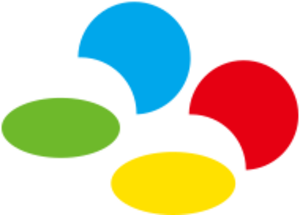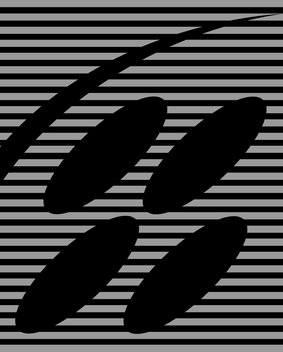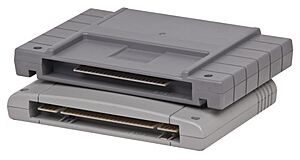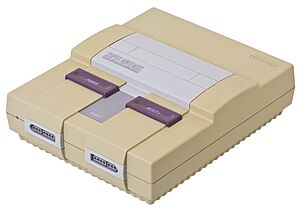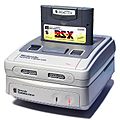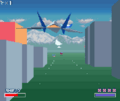Super Nintendo Entertainment System facts for kids
 |
|
 
|
|
| Also known as | SNES Super NES
|
|---|---|
| Developer | Nintendo R&D2 |
| Manufacturer | Nintendo |
| Type | Home video game console |
| Generation | Fourth |
| Release date |
|
| Retail availability | 1990–2005 |
| Introductory price | ¥25,000 (equivalent to ¥27,804 in 2019) US$199 (equivalent to $427.56 in 2022) |
| Discontinued |
|
| Units sold |
|
| Media | ROM cartridge |
| CPU | Ricoh 5A22 @ 3.58 MHz |
| Sound | Nintendo S-SMP |
| Online services | Satellaview (Japan only) XBAND (US and Canada only) Nintendo Power (Japan only) |
| Best-selling game |
|
| Predecessor | NES |
| Successor | Nintendo 64 |
The Super Nintendo Entertainment System, often called Super Nintendo or SNES, is a home video game console made by Nintendo. It was released in Japan and South Korea in 1990. North America got it in 1991, and Europe and Oceania in 1992. In South America, it came out in 1993.
In Japan, it's known as the Super Famicom (SFC). In South Korea, it was called the Super Comboy and sold by Hyundai Electronics. Even though the consoles are similar, different versions had regional lockouts. This meant games from one region often wouldn't work on consoles from another.
The Super NES was Nintendo's second home console. Its first was the Nintendo Entertainment System (NES). The SNES had much better graphics and sound than other systems of its time, like the Sega Genesis. It was also built to use special chips inside game cartridges. These chips made games even better and helped the SNES compete with newer consoles.
The Super NES was very popular around the world. It became the best-selling console of its time. This happened even though it came out later than some rivals. It sold 49.1 million units worldwide before Nintendo stopped making it in 2003. Today, it's still loved by collectors and retro gamers. Many new fan-made games are still being created for it. Nintendo also re-releases classic SNES games on newer systems.
Contents
The Story of Super Nintendo
To compete with Nintendo's popular Family Computer (Famicom) in Japan, other companies launched new consoles. NEC Home Electronics released the PC Engine in 1987. Sega followed with the Mega Drive in 1988. Both of these new systems used 16-bit technology. This meant they had better graphics and sound than the 8-bit NES.
At first, Nintendo wasn't in a hurry to make a new system. But when their sales started to slow down, they changed their minds. They wanted to keep their top spot in the video game market.
Nintendo's president, Hiroshi Yamauchi, first announced the Super Famicom in 1987. He shared more details in 1988, talking about new games like Super Mario Bros. 4. People thought Nintendo made these early announcements to get people excited. This might have stopped them from buying rival consoles for Christmas.
Launching the Console
The Super Famicom was designed by Masayuki Uemura. He also designed the original Famicom. It was released in Japan on November 21, 1990. It cost about 25,000 Japanese Yen. The console was an instant hit. Nintendo's first shipment of 300,000 units sold out in just a few hours.
The Super Famicom quickly became more popular than its rivals. Nintendo got back its lead in the Japanese console market. A big reason for this success was that many game developers stayed with Nintendo. These included popular companies like Capcom, Konami, and Square.
Nintendo released the Super Nintendo Entertainment System in North America. This was a redesigned version of the Super Famicom. It started shipping on August 23, 1991, and cost about $199 US dollars. The official release date across the country was September 9, 1991. The Super NES came out in the United Kingdom and Ireland in April 1992. It cost about 150 British Pounds.
Most of the consoles sold in Europe looked like the Japanese Super Famicom. The main differences were the labels and the length of the controller cords.
How the Super Nintendo Works
The Super NES uses 16-bit technology. This means it can handle more complex graphics and sounds. It has special chips that help create detailed images and simulated 3D effects. It can show 32,768 different colors. The sound system has 8 channels and can play high-quality audio. These features made the Super NES much more advanced than the 8-bit NES. It also had advantages over other 16-bit consoles like the Sega Genesis.
Inside the Console
The main brain of the Super NES is its CPU. It's called the Ricoh 5A22. This chip is based on the 16-bit WDC 65C816 microprocessor. In North America, it usually runs at 3.58 MHz. But it can slow down when it needs to talk to slower parts of the system.
The console has 128 kilobytes (KB) of general memory. This is separate from the memory used for video and audio. The video system has 64 KB of its own memory. The audio system also has 64 KB of memory.
Video and Graphics
The Picture Processing Unit (PPU) handles all the graphics. It has its own memory for video data and for sprites (the moving characters and objects). It also has memory for colors. The PPU can choose from 32,768 colors to create a palette of up to 256 colors on screen at once.
Sound System
The S-SMP audio chip creates all the sounds. It has its own small CPU and a special chip for processing digital signals. It also has 64 KB of memory. This sound chip was designed by Ken Kutaragi and made by Sony. It works completely on its own, separate from the main system. It can create stereo sound with 8 different voices. It can also add effects like echo to the sound.
Regional Differences
Nintendo used a few ways to stop games from one region working in another. This is called regional lockout.
First, the game cartridges themselves were shaped differently. North American cartridges are rectangular with grooves. Cartridges from other regions are narrower and curved. You could use special adapters or change your console to get around this.
Second, there was a special chip inside the console and each game cartridge. This chip stopped games from Europe working on Japanese or North American consoles, and vice versa. Japanese and North American consoles had the same region chip. People found ways to get around this too, often by using adapters or by changing a small part of the console.
Also, TV systems are different around the world. North American TVs use a 60 Hz standard, while European TVs use 50 Hz. This meant European games played slower on North American consoles. And North American games played faster on European consoles. Some people would modify their consoles to switch between these modes.
Console Designs
- Different SNES Console Designs
All Super NES consoles are mostly gray, but with slightly different shades. The original North American version was designed by Lance Barr. It has a boxy shape with purple switches. The top where you put the game cartridge is curved. This was to make it easy to use and to stop people from putting drinks on it. The Japanese and European versions were more rounded with darker gray parts and buttons.
All versions have a slot on top for game cartridges. But the shape of the slot is different for each region to match the cartridges. The console also has a special port called MULTI OUT. This port can send video signals to your TV.
Smaller, Newer Models
Later, Nintendo released a smaller, cheaper version of the console. It was called the New-Style Super NES in North America. In Japan, it was known as the Super Famicom Jr. This new design was also made by Lance Barr. It combined ideas from both the original North American and Japanese consoles. But it was much smaller. This smaller version was not released in Europe.
The power and reset buttons were moved to the left side. The button to eject cartridges and the power light were removed. Inside, the console's parts were combined into a single chip. This made it cheaper to make. The new model also didn't have the expansion port on the bottom. This meant it couldn't use the Japan-only Satellaview add-on.
The new console still had the same video output port. However, it only supported basic video output. You could modify it to get better video quality. The part that sent signals to older TVs was also removed.
This redesigned console came out in North America in October 1997. It cost about $99.95 and came with the game Super Mario World 2: Yoshi's Island. It was released in Japan in March 1998. Nintendo sold it as a cheaper option for people who didn't want to pay a lot for newer systems like the Nintendo 64. Nintendo also made a slightly different controller for it.
Yellowing Plastic
The plastic used in some older Super NES and Super Famicom consoles can turn yellow over time. This happens when the plastic reacts with air. Because the original plastic was very light gray, the yellowing is quite noticeable. Sometimes, different parts of the console might turn yellow at different rates, creating a "two-tone" look. There are ways to clean the plastic and make it look new again.
Game Cartridges
Super NES games come on ROM cartridges. These are officially called Game Paks in most Western countries. In Japan, they were called Cassettes. The largest games released for the SNES were Tales of Phantasia and Star Ocean. They had 48 megabits of game data. The smallest games had only 2 megabits.
Some cartridges also had a battery inside. This battery powered a small amount of memory (SRAM). This memory was used to save your game progress. Cartridges could also have special chips inside. These chips would add extra power or features to the game.
Popular Games
- Super Mario World
- Super Castlevania IV
- Super Mario RPG: Legend of the Seven Stars
- Super Metroid
- Donkey Kong Country
- EarthBound
- The Legend of Zelda: A Link to the Past
- Super Mario Kart
- Super Mario World 2: Yoshi's Island
- F-Zero
- Star Fox
Images for kids
-
The Super Game Boy lets you play Game Boy games on the SNES
-
Satellaview with Super Famicom
See also
 In Spanish: Super Nintendo para niños
In Spanish: Super Nintendo para niños


